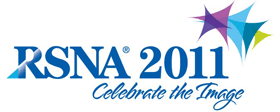
Abstract Archives of the RSNA, 2011
SST14-02
Pediatric MR Imaging-guided Musculoskeletal Interventions: Assessment of Technical Effectiveness and Safety
Scientific Formal (Paper) Presentations
Presented on December 2, 2011
Presented as part of SST14: Pediatrics (Interventional)
Jan Fritz MD, Presenter: Nothing to Disclose
Serban Mateiescu, Abstract Co-Author: Nothing to Disclose
Nikolay Tzaribachev MD, Abstract Co-Author: Nothing to Disclose
John A. Carrino MD, MPH, Abstract Co-Author: Research grant, Siemens AG
Research grant, Carestream Health, Inc
Research Consultant, General Electric Company
Dietrich H.W. Groenemeyer MD, Abstract Co-Author: Stockholder, Standard Instruments GmbH
Philippe Lucien Pereira MD, Abstract Co-Author: Support, Terumo Corporation
Support, Bayer AG
Support, Siemens AG
Support, Bracco Group
Speaker, Terumo Corporation
Speaker, Bayer AG
Speaker, CeloNova BioSciences, Inc
Speaker, Biocompatibles International plc
Research grant, Biocompatibles International plc
To test the hypothesis that interventional magnetic resonance (MR) imaging is technically effective and safe in a broad range of pediatric musculoskeletal interventional procedures.
Procedures were determined by a retrospective search of our patient information systems. Search criteria included the specific descriptor for the interventional MRI systems, age younger than 18 years, and the procedure codes for interventional MR imaging. Procedures were performed with 0.2-Tesla (Magnetom Concerto; Siemens, Erlangen, Germany; n=39) or 1.5-T (Magnetom Espree; Siemens; n=96) open MRI systems. Procedures were evaluated for a.) type, b.) technical success, defined as adequate drug delivery on post-procedural MR imaging or acquisition of an adequate tissue sample for diagnosis at pathologic analysis, c.) total procedural time, and d.) major complications, defined in accordance with the American College of Radiology guidelines.
The search derived 135 procedures, which were performed in 106 subjects (52 girls and 54 boys; mean age, 13.8±2.8 years; range, 3-17 years). Procedures consisted of targeted drug delivery (sacroiliac joint (34, 25%), temporomandibular joints (24, 18%), facet joint (6, 4%), lumbar sympathetic chain (3, 2%), epidural space (26, 19%), spinal nerve root (8, 6%), shoulder (6, 4%) and hip (2, 2%) arthrography, soft tissue biospy (8, 6%), bone biopsy (13, 10%) and preoperative percutaneous tumor marking procedures (5, 4%). Technical success was achieved in 109/109 (100%) drug delivery procedures, 8/8 (100%) soft tissue biopsies, 13/13 osseous biopsies 13/13 (100%) and 5/5 (100%) preoperative percutaneous tumor marking procedures. The average total length of time of procedures was 44.4±19.1 (range, 16-107) min. No major complications occurred. Two minor complications occurred, including transient local bleeding and focal subcutaneous atrophy.
The assessed pediatric MR imaging-guided musculoskeletal interventional procedures are effective and safe for use in clinical practice.
Pediatric MR-guided musculoskeletal interventions favorably combine technical effectiveness, excellent safety profile, and absence of ionizing radiation, and are ready for use in clinical practice.
Fritz, J,
Mateiescu, S,
Tzaribachev, N,
Carrino, J,
Groenemeyer, D,
Pereira, P,
Pediatric MR Imaging-guided Musculoskeletal Interventions: Assessment of Technical Effectiveness and Safety. Radiological Society of North America 2011 Scientific Assembly and Annual Meeting, November 26 - December 2, 2011 ,Chicago IL.
http://archive.rsna.org/2011/11008596.html

